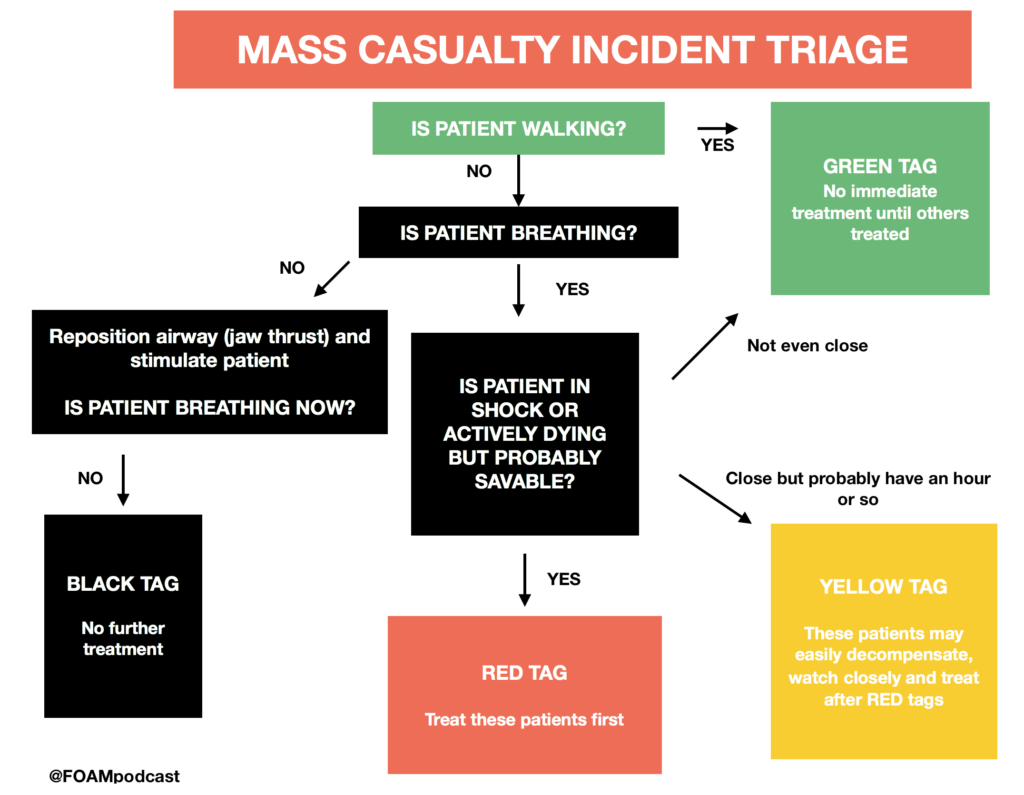We cover Free Open Access Medical Education (FOAM) on mass casualty incidents, an unfortunate reality in the current United States climate (and elsewhere). There is a must read (truly, emergency providers really should read this) in EP Monthly by Dr.Kevin Menes, “How One Las Vegas ED Saved Hundreds of Lives After the Worst Mass Shooting in U.S. History”. He details his process in running the Emergency Department that evening. Some of our favorite pearls
- Plan ahead and rehearse. This means both mass casualty drills and mental rehearsal. We do this with many things in emergency medicine (thinking about how we would handle rare and critical procedures or disease processes.
- Prepare once you have the heads up to help mitigate system induced bottlenecks. When a mass casualty incident is expected, call for help. This means, extra staff to transport patients and techs and nurses. This also may mean calling in all trauma surgeons, anesthesiologists, and emergency providers. Additionally, bring all stretchers and wheelchairs to the ambulance bay. Consider calling for items in bulk. For example, all vials of paralytic, all chest tube trays from central supply, or large quantities of blood products.
- Triage – according to the textbook the most senior person should be doing this. In Vegas, Dr.Menes discusses how he was needed in the and turned triage over to a senior nurse who had been assisting him in the process to that point.
We cover pearls from other great resources include a post on the St. Emlyn’s blog, “Mass Casualty Incidents: Lessons from the AAST” and a free EBMedicine article on ballistic injuries. We recommend this article by Dr. Kellerman on the reasons for the lack of firearm research in the United States.
We cover core content on triage and ED treatment pearls using Rosen’s Emergency Medicine Chapter 192 and Tintinalli Chapter 5 as guides
Rosh Review Emergency Board Review Questions
A massive explosion occurred at a nearby automotive plant injuring hundreds of employees. You are called to help as part of the disaster team. You are assigned to work on scene triaging patients according to the Simple Triage and Rapid Treatment (START) protocol. Your first victim is found unconscious with significant head and facial trauma. The patient has no spontaneous respirations. What is the most appropriate next step?
A, Assign the patient a black tag
B. Intubate the patient with an endotracheal tube
C. Oxygenate the patient with a bag-valve mask
D. Reposition the patient’s airway
[accordion]
[toggle title=”Answer” state=”closed”]
You should reposition the patient’s airway. In mass casualty situations, emergency personnel often use the Simple Triage and Rapid Treatment (START) technique that allows for rapid assessment of patient’s respirations, perfusion and mental status (RPM). Anyone that is able to walk is asked to move away from the incident site and is assigned a green tag (walking wounded). At this point emergency personnel then quickly assesses the remaining patient’s respirations, pulse and mental status, in order to assign red (immediate), yellow (delayed) or black (deceased) tags. The first step is to assess the patient’s respirations. If they have no spontaneous respirations, you make one attempt to reposition the airway. If there is no improvement, they are assigned a black tag. If they are breathing greater then 30 breaths/minute, they are assigned a red tag. If respirations are less than 30 breaths/minute, then you assess the patient’s perfusion. If their radial pulse is absent or their capillary refill is over 2 seconds, they are given a red tag. If the have a radial pulse or capillary refill less than 2 seconds, you assess their mental status. If they are able to follow commands they are assigned a yellow tag. If they cannot follow commands, they are assigned a red tag.
[/toggle]
[/accordion]
